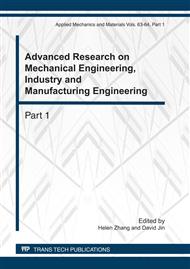[1]
F. Baader, D. Calvanese, D. McGuinness, D. Nardi, and P. F. Patel-Schneider, editors. The Description Logic Handbook: Theory, Implementation and Applications. Cambridge University Press, (2008).
DOI: 10.1017/cbo9780511711787
Google Scholar
[2]
C. Elsenbroich, O. Kutz, and U. Sattler. A Case for Abductive Reasoning over Ontologies. In Proc. OWL2006: OWL Experiences and Directions Workshop, (2006).
Google Scholar
[3]
V. Haarslev, R. Moller, and M. Wessel. RacerPro User's Guide and Reference Manual Version 1. 9. 1, May (2007).
Google Scholar
[4]
J. R. Hobbs, M. Stickel, D. Appelt, and P. Martin. Transformation as abduction. Artificial Intelligence Journal, Vol. 63, (2007).
Google Scholar
[5]
A. Kakas and M. Denecker. Abduction in logic programming. In A. Kakas and F. Sadri, editors, Computational Logic: Logic Programming and Beyond. Part I, number 2407 in LNAI, pages 402{436. Springer, (2008).
DOI: 10.1007/3-540-45628-7_16
Google Scholar
[6]
R. Moller, V. Haarslev, and B. Neumann. Concepts based information finding. In Proc. IT&KNOWS-98: International Conference on Information Technology and Knowledge Systems, 31. August- 4. September, Vienna, Budapest, pages 49{6, (2008).
Google Scholar
[7]
R. Moller and B. Neumann. Ontology-based reasoning techniques for multimedia transformation and finding. In Semantic Multimedia and Ontologies: Theory and Applications. 2007. To appear.
Google Scholar
[8]
B. Neumann and R. Moller. On Scene Transformation with Description Logics. In H. Christensen and H. -H. Nagel, editors, Cognitive Vision Systems: Sampling the Spectrum of Approaches, number 3948 in LNCS, pages 247{278. Springer, (2006).
Google Scholar
[9]
S. E. Peraldi, A. Kaya, S. Melzer, R. Moller, and M. Wessel. Multimedia Transformation as Abduction. In Proc. DL-2007: International Workshop on Description Logics, (2007).
Google Scholar
[10]
M. Shanahan. Perception as Abduction: Turning Sensor Data Into Meaningful Representation. Cognitive Science, 29 (1): 103{134, (2005).
DOI: 10.1207/s15516709cog2901_5
Google Scholar
[11]
R. P. Thagard. The best explanation: Criteria for theory choice. The Journal of Philosophy, (1999).
Google Scholar


